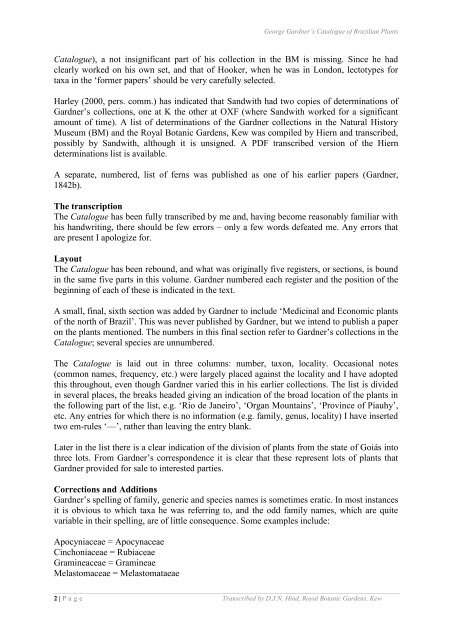Catalogue of Brazilian Plants - Royal Botanic Gardens, Kew
Catalogue of Brazilian Plants - Royal Botanic Gardens, Kew
Catalogue of Brazilian Plants - Royal Botanic Gardens, Kew
You also want an ePaper? Increase the reach of your titles
YUMPU automatically turns print PDFs into web optimized ePapers that Google loves.
George Gardner’s <strong>Catalogue</strong> <strong>of</strong> <strong>Brazilian</strong> <strong>Plants</strong><br />
<strong>Catalogue</strong>), a not insignificant part <strong>of</strong> his collection in the BM is missing. Since he had<br />
clearly worked on his own set, and that <strong>of</strong> Hooker, when he was in London, lectotypes for<br />
taxa in the ‘former papers’ should be very carefully selected.<br />
Harley (2000, pers. comm.) has indicated that Sandwith had two copies <strong>of</strong> determinations <strong>of</strong><br />
Gardner’s collections, one at K the other at OXF (where Sandwith worked for a significant<br />
amount <strong>of</strong> time). A list <strong>of</strong> determinations <strong>of</strong> the Gardner collections in the Natural History<br />
Museum (BM) and the <strong>Royal</strong> <strong>Botanic</strong> <strong>Gardens</strong>, <strong>Kew</strong> was compiled by Hiern and transcribed,<br />
possibly by Sandwith, although it is unsigned. A PDF transcribed version <strong>of</strong> the Hiern<br />
determinations list is available.<br />
A separate, numbered, list <strong>of</strong> ferns was published as one <strong>of</strong> his earlier papers (Gardner,<br />
1842b).<br />
The transcription<br />
The <strong>Catalogue</strong> has been fully transcribed by me and, having become reasonably familiar with<br />
his handwriting, there should be few errors – only a few words defeated me. Any errors that<br />
are present I apologize for.<br />
Layout<br />
The <strong>Catalogue</strong> has been rebound, and what was originally five registers, or sections, is bound<br />
in the same five parts in this volume. Gardner numbered each register and the position <strong>of</strong> the<br />
beginning <strong>of</strong> each <strong>of</strong> these is indicated in the text.<br />
A small, final, sixth section was added by Gardner to include ‘Medicinal and Economic plants<br />
<strong>of</strong> the north <strong>of</strong> Brazil’. This was never published by Gardner, but we intend to publish a paper<br />
on the plants mentioned. The numbers in this final section refer to Gardner’s collections in the<br />
<strong>Catalogue</strong>; several species are unnumbered.<br />
The <strong>Catalogue</strong> is laid out in three columns: number, taxon, locality. Occasional notes<br />
(common names, frequency, etc.) were largely placed against the locality and I have adopted<br />
this throughout, even though Gardner varied this in his earlier collections. The list is divided<br />
in several places, the breaks headed giving an indication <strong>of</strong> the broad location <strong>of</strong> the plants in<br />
the following part <strong>of</strong> the list, e.g. ‘Rio de Janeiro’, ‘Organ Mountains’, ‘Province <strong>of</strong> Piauhy’,<br />
etc. Any entries for which there is no information (e.g. family, genus, locality) I have inserted<br />
two em-rules ‘––’, rather than leaving the entry blank.<br />
Later in the list there is a clear indication <strong>of</strong> the division <strong>of</strong> plants from the state <strong>of</strong> Goiás into<br />
three lots. From Gardner’s correspondence it is clear that these represent lots <strong>of</strong> plants that<br />
Gardner provided for sale to interested parties.<br />
Corrections and Additions<br />
Gardner’s spelling <strong>of</strong> family, generic and species names is sometimes eratic. In most instances<br />
it is obvious to which taxa he was referring to, and the odd family names, which are quite<br />
variable in their spelling, are <strong>of</strong> little consequence. Some examples include:<br />
Apocyniaceae = Apocynaceae<br />
Cinchoniaceae = Rubiaceae<br />
Gramineaceae = Gramineae<br />
Melastomaceae = Melastomataeae<br />
2 | P a g e Transcribed by D.J.N. Hind, <strong>Royal</strong> <strong>Botanic</strong> <strong>Gardens</strong>, <strong>Kew</strong>

















